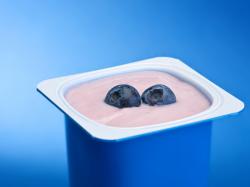Flavored Yogurts & Enhanced Milk Top Dairy Trends
April 18, 2012 | 3 min to read

Madison, WI — As consumers pay more attention to their health, yogurt and enhanced milk are topping dairy product trends, according to What’s in Store 2012, the annual trends report of the International Dairy-Deli-Bakery Association™ (IDDBA)
Yogurt sales and consumption climb
Yogurt dollar sales rose 7.0% to $5.2 billion in the food/drug/mass channel in the 52-week period ending May 14, 2011, according to Nielsen. In 2010, Americans ate yogurt 7.5 times per month on average, up from 7.0 times per month in 2006, Mintel reported. What’s in Store is a secondary research trends report compiled from over 150 credible industry resources.
Yogurt brands continue to expand their varieties, particularly in the popular Greek yogurt section. Greek yogurt smoothies, new fruity flavors, and yogurt can be substitutes for sour cream, mayonnaise, and cream cheese in recipes. Cappuccino yogurt with almond crisp, orange yogurt with sea buckthorn, maple, and strawberry rhubarb,
for example, are some of the newer flavors.
Craft yogurts are also trendy in the dairy case. Since 2005, 30% of new product launches in the category have been craft products, which tout their milk sources and traditional processes, Specialty Food Magazine reported. Many feature milk from grass-fed cows, local flavorings, or alternative milks, including sheep’s milk and goat milk, as well as artisanal yogurt in reusable glass or ceramic containers.
Enhanced milk offers more for all age groups
Enhanced milk is one of the new offerings in the dairy case that offers consumers more health options. Aside from vitamin milk concocted with special blends to cater to kids, teens, and women, there are also milk blends of cows’ milk and nut milks. Kids can get milk in flexible ‘squeezy pouches’ with a screw tops that make it fun to drink, as well as flavored varieties with less sugar and fewer calories. Protein-rich milks with added vitamins, are popular, as are meal-replacement shakes and sleep-provoking beverages that contain milk, soy, valerian root extract and melatonin. Milk tops the list of food purchased most often because of an added benefit or fortification.
Better-for-you and better-for-the environment are top dairy trends as consumers lean toward products with natural nutritional properties, functional additives, and sustainably produced actions. Dairy products make up 14.6% of organic food sales, second to the fruit and vegetable category, which commanded 39.7% of the market. Organic dairy product sales rose by 9% in 2010 to total $3.9 billion in 2010, according to the Organic Trade Association.
Euromonitor projects the U.S. dairy market will grow to $53 million by 2015, up 5.2% from 2010.
U.S. Dairy Consumption Rises
The most recent data shows U.S. dairy product consumption rose to 607.1 pounds per capita in 2009 from 603.7 pounds in 2008, according to the USDA. Consumer units, typically defined as households, spent $409 annually on dairy products, the most recent data (2009) show. This decrease of 4.9% from the year before comes amid an across-the-board consumer spending decline.
Household penetration for dairy products is 99.6%, with milk and cheese topping the list at 97% and 96.9% respectively, Perishables Group found. Consumers average 34.8 dairy department shopping trips per year. More than half of these shopping trips include multiple items from the dairy case.
What's in Store 2012, our 26th edition, is a 200+ page trends report that details consumer and industry trends affecting the dairy case, cheese case, bakery, deli, and foodservice supermarket departments. The report along with its 185+ tables was developed in cooperation with leading industry companies, publications, press and Web services and associations. It includes department sales, per capita consumption, consumer preferences, and random-weight, UPC, and private label sales data. The full report is available from IDDBA. The cost is $99 for IDDBA members and $399 for non-members, plus shipping and handling. Along with the book, readers have access to What's in Store Online, featuring over 50 quarterly-updated, downloadable, color sales tables with random-weight (PLU), UPC, and system 2-coded data. In addition, the Web site offers timely white papers, trends articles, and links for all of the businesses that are referenced in the What's in Store book. For more information, or to order, call the IDDBA Education Department at 608.310.5000 or visit the organization's Web site, www.iddba.org.
About IDDBA:
IDDBA is a nonprofit membership organization serving the dairy, deli, bakery, cheese, and supermarket foodservice industries. Member companies enjoy many benefits and services including the annual seminar and expo, leading-edge research, training programs, management tools, and an annual trends report. For more information, contact IDDBA at 608.310.5000 or visit our Web site, www.iddba.org.
Source: International Dairy-Deli-Bakery Association™
